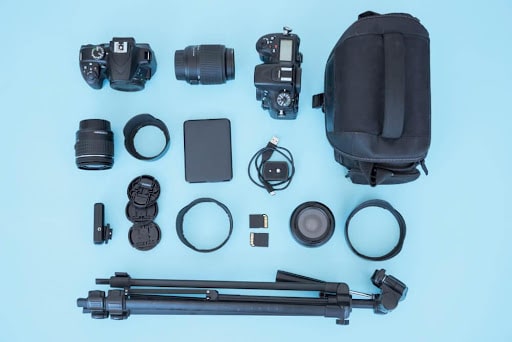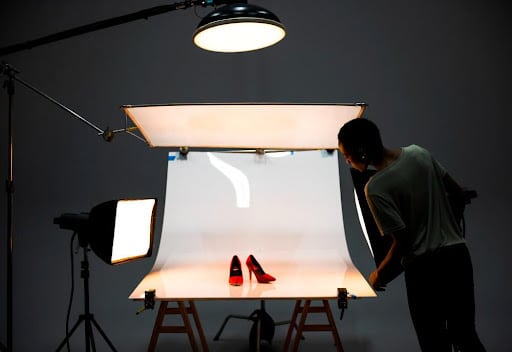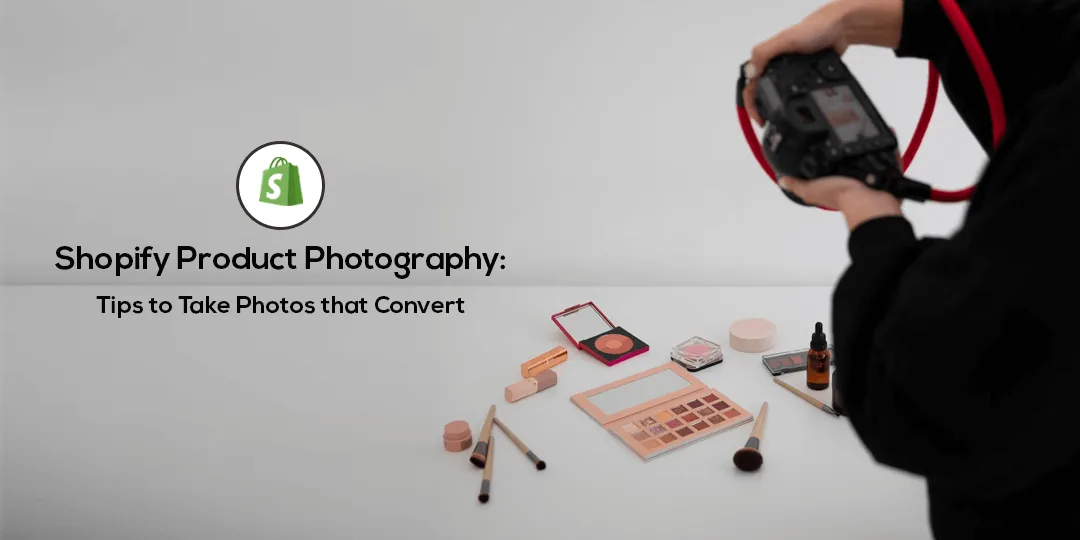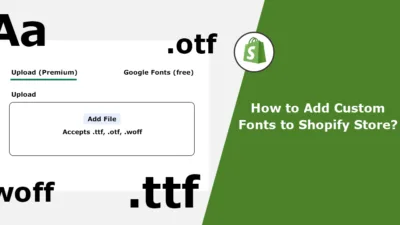When it comes to selling products on Shopify, online presentation and image quality matter most. But the question is: how do you fulfill your business goal? Or, how do you convert your site visitors into regular ones through Shopify product photography?
In this article, we’ll give you a step-by-step guide on photography theory, essential equipment, photoshoot ideas, and post-production to improve your marketing efforts.
What is Shopify Product Photography?
Shopify product photography indicates all the processes, like capturing, editing, and optimizing product photos for the Shopify store. The purpose of this photograph is to convince shoppers to make a purchase by highlighting products in the best possible light, angle, or setup.
However, focus on eye-catchy and precise photography feature product details – supplemental to written copy and descriptions to give buyers a full impression of the product.
Why are Photography Products Important in Shopify Store?

In the ecommerce marketplace, 90% of online shoppers rely on product imagery to confirm their purchase decision and 22% of online returns happened for it. That means the visual presentation is the main thing that affects both business/product value and consumer trust.
For more details, let’s explore some key factors why having high-quality, clear, and professional product photos are important for your Shopify store.
- Professional presentation: High-resolution images meet your consumers’ expectations and rich your ecommerce business storefront.
- Build Trust: Help to create a positive impression on your potential customers by offering clear product information (color, pattern, style, shape, and quality).
- Reinforce branding: Professional product photography highlights consistent lighting, backgrounds, and other relevant elements to boost your ecommerce branding.
- Encourage sharing: Visually appealing product photos work well on Instagram, Facebook, and other social media platforms that turn followers into potential customers.
- Offer realistic vibes: Pixel-perfect product images with different angles gives online shoppers a real-life experience that reduces product return rate.
- Keeps competitors away: High-quality images highlight in-depth product details that differentiate from your competitors and gain more market share.
The power of product photography is undeniable and creative ones have the power to grab your targeted audience’s attention instantly. Want to boost your business sales with lots of conversations?
Let’s check out the next section to capture breathtaking and eye-pleasing product photos that convince online shoppers to buy products at a glance.
How Do I Take Good Product Photos on Shopify?

Now that you understand how important product photography is for your Shopify store, time to push your creativity to new heights. Here we’ve enlisted top tips for creating breath-taking and compelling product photographs that sell.
Let’s get started!
Proper Prior Planning
The first step for shooting photography products is to develop a clear concept, like who is your target audience. What is the purpose of photos and how many variations or products do you plan to include in your Shopify store?
To demonstrate the product’s unique look and create concepts, you need to clarify some factors, including:
- How do you want to represent your brand product?
Finalize your product’s ultimate goal, like classy, professional, fun concepts, or creative. Whatever product representation type you choose, focus on your consumers’ desires and requirements.
- Which product qualities do you want to show through your photos?
Do you want to highlight products specific features/functions, use cases, ingredients, or trendy styles along with a mindblowing set-up?
- Which product photography type do you choose to showcase your products?
After selecting your target audience and their requirements, you need to focus on the types of product shots, like:
❖ Individual photography – To highlight individual products’ full collection (size, color, and clean look), this shot is best for product pages, banner images, and product catalogs. Just like Amazon, you can shoot the product on white background.
❖ Group product photography – If you want to display the range and variety of your products or give shoppers a complete view group shots are perfect. Also, these photos fit well on social media posts and advertisements.
❖ Lifestyle product photography – Want to make your products more personal? These shots tell the story behind the product and give customers a real-life experience of product use in their daily lives.
❖ Detailed or close-up shots – For showing off small items sharp details or jewelry luxuries view, detailed shots are the best than traditional ones.
❖ Packaging shots – To build trust and give a better shopping experience, you can shoot products with packaging if have any.
❖ Scale shots – Do you want to show how big or small the product is? You can display products next to other items. For jewelry products, you can add hands or wear them.
Essential Equipment for Product Photography

The next step is to select the perfect photography equipment based on your goals, budget, location, and product requirements. Let’s check out essential lists of the best equipment for product photography below:
Camera
You might be wondering, will you need an expensive camera to capture the essence of products and produce high-quality ones? Most professional product photographers prefer to use DSLR and mirrorless cameras with a wider range of settings and features, including:
- Interchangeable lens options,
- ISO, shutter speed, aperture flexibility,
- And so on.
But remember one thing the higher the camera’s megapixel count, the higher the picture quality you achieve. You have many brand options, like Nikon, Canon, and other camera series. If you have budget limitations, a high-resolution phone camera works as a great life-savor.
Lens
Lenses can make or break your product photography’s actual look. So, after choosing a camera, pay attention to photography types for selecting lenses. For outdoor shooting a longer lens of 100mm or more is great. But for small details or wider-angle shots macro lens (20mm) is best.
However, to be a pro product photographer having experience using different lenses is a good thing. Also, you can successfully overcome all challenges and identify which lens suits you best for jewelry, attire, or other products.
Tripod & Shutter Release
If you want to eliminate blur from your product images, a tripod and shutter release both are needed. For shooting static product photos, avoid using the autofocus function on your camera.
Also, ensure to use of a shutter release cable to reduce unnecessary movement of the camera. From shooting multiple lifestyle product photos, i.e., adding smoke, reflections on water, or shooting from unusual angles, set the camera on a tripod and take advantage of shutter release.
Kit cleansing
As a product photographer, your goal is to capture the product’s uniqueness in a convincing way. Kit cleansings, like glass cleaner, scissors, goof off (remove labels, fingerprints, and dust), and others help you to make high-quality photos.
However, all these things save lots of time in post-production. If you photograph clothes or fabrics, pay attention to unwanted wrinkles.
Choosing the Right Studio Backdrop
Backdrops and props help to set the mood for your product. Before selecting one consider the feelings to evoke your audience and try to portray the products’ real beauty. Align your brand and product story first, such as:
- Commercial product photography: Bold colors, simple backgrounds, and clean lines make a great impact on this genre of photography. All you need to highlight the product’s story by itself.
- Theme – Do you want to shoot hanging products, mirror reflections, add movement, play with levels, or embrace the beauty of the season? Choose backdrops that add extra compliment to your theme.
- Romantic – If you want to shoot perfumes, jewelry, or other products, soft lighting, warm colors, and beautiful settings invoke feelings of romance.
- Flat lay – Do you want to represent the multi-faceted approach to products? Flat lay is the best option for ecommerce advertising and brand site banners.
Wondering which backdrop is best for your brand or Shopify pictures? Here we’ve listed different creative backdrop ideas so that you can make your own irresistible product images.
- Vinyl backdrops – Thick and reliable backdrops come in different styles, i.e., faux marble, faux wood, and solid colors without any reflections and glare.
- Fabric & cloth backdrops – Lace, leather, silk, and other cool fabrics are used for jewelry or watch product photography.
- Stone or sand backdrops – If you want to add texture and creative things to your ring jewelry products, this backdrop is the best.
- Rug backdrops – Want to opt for patterned and balanced product looks? Colorful rugs or white ones give an interesting texture that suits your product.
Apart from this, you have different options, like patterns, tiles, powder imprints, paper, ice, colorful backgrounds, rocks, wood, and so on.
Deep Dive into Color Theory and Psychology
For taking good product photos, you need to understand the color wheel which provides relevant combinations that are appealing to the human eye. For example:
- Complementary colors indicate direct colors that are opposite each other.
- Analogous colors or “cousin colors” are three colors that are placed next to each other on the wheel. These colors are best for landscape photography.
- Triadic colors are red, blue, and yellow.
- Monochrome colors refer to any composition that is used a single hue, or variations of its tones and shades.
However, we all know that colors have a strong influence on our emotions. For example, golden hour photography compared to gray or cloudy days. So, to maintain color psychology, you need to focus on emotions, including:
- Red symbolizes strength, passing, and anger.
- Orange presents fun, vitality, cheerfulness, and others.
- Yellow shows off warmth, joy, and happiness.
- Green represents nature’s beauty and calm.
- Blue symbolizes sadness, cold, and balance.
Using Natural or Artificial Light

Sunlight or natural light is also known as “soft light”. For outdoor photography, food, people, and other lifestyle product images, this light source is the best choice. Also, to narrow down the product’s surroundings and relate your audience with products, you can try outdoor shoots.
| Pro Tip: For indoor shoots, place your product in front of a window and turn off other lights. On the other hand, for outdoor shoots golden hours is the best option. |
Artificial or studio lights refer to candles, fires, light bulbs, or other “hard light” that produces smaller, yet focused light surfaces. If you want to sell earphones or phone cases, you can create a story and use artificial product photography lighting.
Shoot from a Variety of Unique Camera Angles
If you want to represent your product’s creative and unique look to online shoppers, try different camera angles, such as –
- Front angle – Shoot from eye-level or front-on products to make them identifiable. It provides neat and clean product images for your Shopify store and ecommerce sites.
- Profile angle – This photo is taken from one side of the product. Most of the time to highlight the product logo this shooting angle is required, i.e., sneaker shots.
- Three-quarter – 45deg product view that is taken from a high-level angle. You can use this angle for shooting multiple products.
- Back angle – Do you want to add product ingredients or feature details? You can add context with this angel.
- Birds-eye view or high angle – The images are taken from above to add extra details of products.
- Low angle – When you want to give products a creative look or provide the size of products, you can use this angle.
Consider 360 Degree Product Photos
This type of product photography helps to reduce the return rate and compete with your competitors. Also, it allows online shoppers to view the product in 360 degrees just like brick-and-mortar shops view. For creating, you need to:
- Place the product on a turntable.
- Turn the table from left to right or vice versa.
- After completing the rotation, upload photos on the 360 product photography program to animate.
- You can upload animated files to your desired site.
Creating a Well-Crafted Product Story
Product storytelling is an effective medium to communicate with consumers and help them to solve problems rather than focusing on the product’s features. Here, you need to narrow down two key things: why they choose/buy the product and how the product meets their pain points.
Do you want to create a convincing and well-crafted Shopify product pictures story? Let’s look at 6 key hacks below:
- Start with questions: To portray a compelling product story first understand your customers. To build engagement with your potential shoppers, you can ask different questions like:
❖ What encourages consumers to buy the product?
❖ How do they experience/feel after using/purchasing the product?
❖ Which factors give you the confidence to trust us?
- Get clear ideas about your buyer persona: Buyer persona helps to identify the ideal audience (their needs, job role, etc.) for your product. And to build a marketing strategy the analysis helps to convey perfect emotions through messages to your end users.
- Create urgency and solve your audience’s problems: The product story is a combinational part that highlights users’ desires, problems, and solutions. To catch the audience’s attention to your producers highlight the positive impact and create urgency.
- Relatable product story: Try to build a connection with emotion and human interactions via your product story. Remember, the more relatable story is, the deeper the emotional response you get from shoppers.
- Chose story medium to craft your message: Considering your audience’s preferences and likings, choose your storytelling formats, such as –
❖ In-app: tooltips, checklists, banners, and others
❖ Text: The most popular content marketing medium that suits blogs, eBooks, and newsletters.
❖ Audio & Digital: You can record your story ideas or can take advantage of video marketing.
- Include relevant CTA: After narrowing down your masterpiece story, add CTA to evoke consumers to take action to your messages.
Remember Brand Identity and Guide
Crafting a unique brand identity is a big part of ecommerce management. Brand identity is all about representing the company’s visual details, like logos, color palette, typography, other imagery/photography, iconography, unique voice, and tone. Brand guidelines help to build authenticity and loyalty among consumers.
Do you want to represent your brand and guide through Shopify photography? Let’s look at some examples of killer brand guidelines below:
- Walmart: The brand includes a logo, photography, typography, illustrations, voice, editorial style, and more. Also, their primary color is known as “Walmart Blue”.
- Starbucks: Their iconic Siren logo and green color palette make them unique. Plus, the visual suits different seasonal product launches and campaigns.
- TikTok: Its in-depth look brings the brand to life via its creative logo design, co-branding, color, and typography. The logo highlights the relentless energy and expression of users.
For more brand guidelines, look at Netflix, NASA, Audi, and so on. However, after acknowledging the brand guide, wondering how to edit product photography.
Go through the next section now!
How Do I Bulk Edit Product Images for Shopify?

For Shopify bulk product image edits, you have two options: one is using editor tools and another is outsourcing ecommerce product photo editing. If you have enough time you can do it by yourself, but it requires Photoshop skills.
Let’s take a closer look at some key factors about editor tools vs. professional editing services!
| Key Factors | Editor Tools | Professional Editors |
| Efficiency | AI editing tools or software can’t provide professional standards results. | Professional editor’s hands-on retouching & advanced editing tools skills help you to provide the perfect product looks. |
| Turnaround Time | Faster turnaround time, but has image quality issues. | Deliver bulk edits within the estimated time frame & maintain image quality. |
| Cost | Free software or tools has some limitations, but to buy premium ones you need to invest more. | Professional editors offer cost-friendly solutions to edit your images. |
| Brand style | Don’t follow the brand guide. | Pay attention to every brand detail to convince consumers. |
| Consistency & accuracy | Has resolution, color matching, complex edits, and other editing issues. | Outsourcing professional retouchers, you get pixel-perfect results. |
FAQs About Product Photography in Shopify
(1) What is the ideal product image size in Shopify?
Answer: The ideal product image size in Shopify is 2048 by 2048 pixels (square product photos). But you can upload images up to 4472 by 4472 pixels with a file size of 20 megabytes.
Note: For high-quality zoom functionalities, your images need to be more than 800 by 800 pixels.
(2) What image format is best for the Shopify store?
Answer: The Shopify store supports different image formats, such as JPEG, progressive JPEG, PNG, GIF, HEIC, WebP, and AVIF.
| Note: Shopify automatically detects your customer’s browser-supported image formats and displays the image in the best available format. |
(3) Does Shopify automatically resize images?
Answer: Shopify offers crop and resizes operations for your images. All you need to upload the best product quality images.
(4) How Many Images Can a Product Have Shopify?
Answer: Shopify allows 250 images per product. But to fasten your store loading speed, it is advisable not to upload this many photos.
(5) How do I SEO an image in Shopify?
Answer: For Shopify image optimization, you need to follow different steps, such as –
- Use images with correct names: Relevant keywords help to reach your targeted SEO rankings by improving your On-page SEO. That’s why ensure you use keyword-rich file names and descriptions. For example, Rolls-Royce Phantom Series 2 Long 2023.
- Include alt attributes carefully: Alt attributes are the alternative to image texts and are used for web accessibility. When the image is rendered, the alt attributes are shown. Let’s take a look at some rules to apply alt:
❖ Describe your product images in plain language, just like image file names.
❖ If your product has any serial numbers, model numbers, or editions, mention them in alt attributes.
❖ Don’t include full keywords in alt attributes. For example: “Diamond jewelry with blue cubic now is available in your nearby outlet”.
❖ Avoid using alt attributes for image decoration.
- Resize product images: Must keep product image files below 70KB. For larger images, you can use compressed image tools, like Canva, GIMP, PIXLR, etc.
- Image format: JPEG file format provides the best quality for the smallest file size, and suits perfectly for ecommerce product images. Avoid using GIFs for large product images. PNGs are the best format and you can use PNG-8 over PNG-24.
- Image thumbnails: For ecommerce sites, use thumbnail images on category pages and ensure the file is small.
- Image sitemaps: If you want to provide an overall shopping experience, add image sitemaps by following Google guidelines.
Conclusion
You now have all equipment lists along with hacks to take amazing and breathtaking Shopify product photography. So, what are you waiting for? Utilize your creativity and follow our photography tricks to spread your magic through images.












